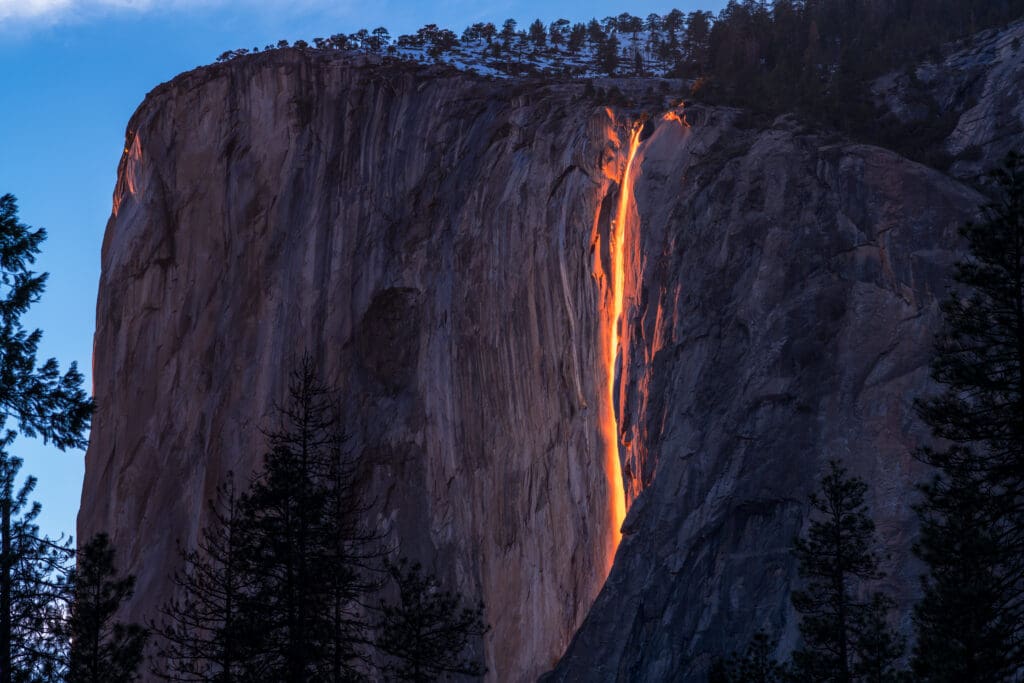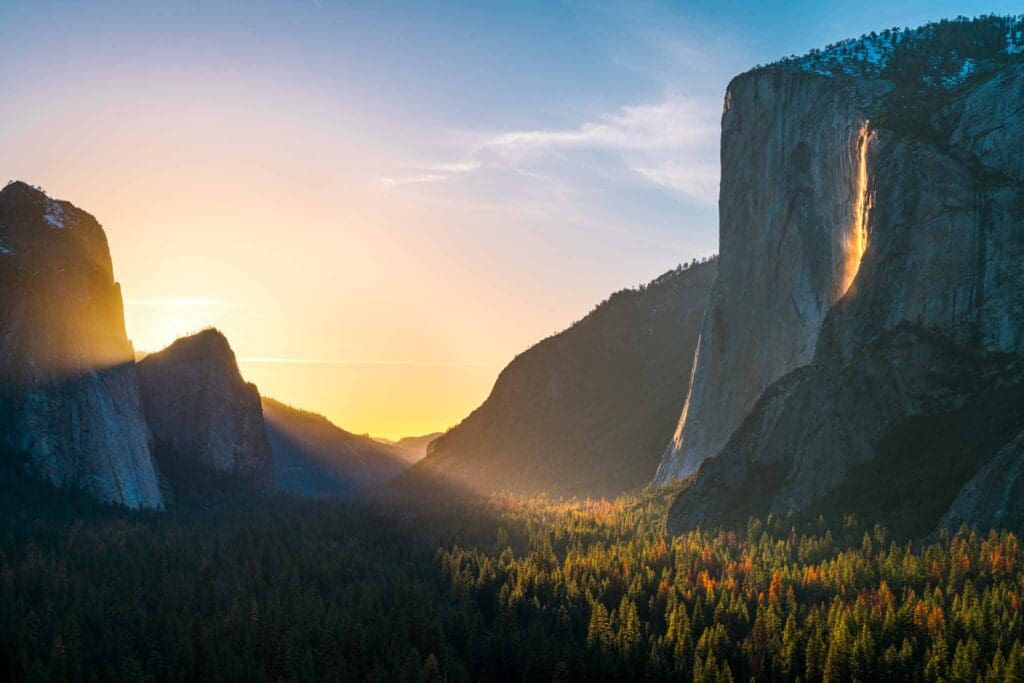|
Getting your Trinity Audio player ready...
|
As the February sun sets, Horsetail Fall ignites into a fiery display, cascading down El Capitan. The perfect weather creates a breathtaking scene at Yosemite’s Firefall. Adventure awaits for those lucky enough to witness this natural wonder.
Each February, a magical phenomenon takes place in Yosemite Valley. Adventurers and photographers alike flock to witness the Firefall at Horsetail Falls. The perfect convergence of sunlight and water creates a fiery orange display that leaves viewers in awe. Cameras snap, gasps escape from lips, and embraces are shared as people bask in the breathtaking sight before them. If you crave an unforgettable journey through nature and want to experience this extraordinary event in 2024, here is everything you need to know about Horsetail Falls and how to fully immerse yourself in its magnificence.
History of the Firefall
Let’s take a step back and delve into some background information. How did the term “Firefall” come about? The name can be traced back to a fascinating history of stunning visual displays in Yosemite Valley. In 1872, the owners of the Mountain House Hotel began a tradition of pushing a bonfire off Glacier Point. From below, onlookers could see a cascade of glowing embers that resembled a fiery waterfall. This practice continued intermittently over the years, but by the mid-1900s, it had gained popularity and thousands flocked to Yosemite to witness the mesmerizing Firefall. Thus, this was the original Firefall in Yosemite.
During the late 19th century, James McCauley owned a small hotel atop Glacier Point, one of many entrepreneurial endeavors that emerged during the early days of Yosemite tourism. His sons, who rode the Four-Mile Trail down to the valley floor for school, were approached by tourists who claimed to have seen a campfire on Glacier Point the night before. The visitors gave them money and asked if their father could recreate the spectacle.
And so, a tradition was born. After collecting funds from tourists after school, the McCauley boys would load firewood onto their pack animals and bring it back up the cliffs for that evening’s fire. Once hotel guests had finished singing and chatting around the campfire, McCauley himself would extinguish it by kicking it over Glacier Point. The glowing embers resembled a waterfall set ablaze, thus creating Yosemite’s iconic firefall.
By January of 1968, George Hartzog, the director of the National Park Service, put an end to the man-made event that involved a bonfire being pushed off Glacier Point in Yosemite. This tradition went against the park’s mission to preserve its natural beauty. The large crowds were causing damage to the meadows and the concessionaires had to constantly find more red fir bark for their fires. It was also creating a fire hazard.
Just five years after this event ended, a photographer named Galen Rowell stumbled upon a similar phenomenon while driving out of the valley on Southside Drive. A waterfall on El Capitan appeared to glow in the setting sun and he quickly captured it on camera, creating the first widely-circulated color photograph of the natural “Firefall” in Yosemite National Park. With the memory of the man-made event still fresh in people’s minds, this new natural phenomenon was soon dubbed the “natural Yosemite Firefall.”

Yosemite Firefall
Experience Yosemite’s Firefall
Most of the year, Horsetail Falls is one of Yosemite’s less-remarkable waterfalls. Although it drops an impressive 2,130 feet (650 m), the small stream at the top of El Capitan doesn’t have the massive volume of some of the more well-known waterfalls like Yosemite Falls or Bridalveil Fall. Fed exclusively through snowmelt and run-off, it dries up in the summer months and disappears entirely.
However, for a few weeks starting in February, everything comes together to make this humble waterfall into a natural Firefall – Yosemite’s own international celebrity. Several factors go into creating this magnificent spectacle. The setting sun casts a golden glow on the waterfall near El Capitan, creating the illusion of fire or a river of gold cascading down the valley’s 1,570-foot cliffs. Photographers will undoubtedly want to capture this breathtaking spectacle. For optimal viewing, head to the El Capitan picnic area.
Factors Required to Create the Firefall
But for a brief period of time in February, all the elements align to transform this modest waterfall into the renowned Firefall – Yosemite’s own internationally acclaimed wonder. Multiple factors play a role in creating this awe-inspiring display.
It only happens once a year, but when the sun, waterfall, and viewer are perfectly aligned, it creates a magnificent sight. This rare occurrence takes place in mid-to-late February, so if you want to witness it, make sure you’re in the right spot at the right time.
The second factor needed for the Yosemite fire waterfall effect is a sufficient amount of water in Horsetail Fall. To achieve this, there must be snow on the ground to provide the source of the waterfall’s flow. Additionally, the temperature must be warm enough during the day to melt the snow and send it cascading over the edge of the fall. If it happens to be extremely cold, although the cliff surrounding the waterfall will still light up with the setting sun, you won’t witness the mesmerizing stream of molten fire without an ample amount of water.
Before planning your trip, take a look at the Yosemite Falls webcam to gauge the water level in Horsetail Fall. This will give you an idea of the current flow rate. Additionally, make sure to monitor the Yosemite weather forecast during late January and early February.”
Even when the sun is in the perfect position and Horsetail Fall has enough water to catch its rays, the Firefall may not appear if clouds obscure the sun during the crucial minutes of sunset. As a result, many people avoid making the trip to see it if there is a forecast for cloudy weather. However, if the clouds happen to part just enough to let a beam of sunlight through, it creates a unique image with the Firefall set against a stunning backdrop of pink clouds.

Yosemite Firefall
Seeing the Firefall
As the sun begins to dip below the horizon, Horsetail Fall and the cliff it cascades down are illuminated by the golden light. This breathtaking moment typically occurs 5 to 15 minutes before sunset during the latter half of February, but capturing it requires several hours of preparation and planning. Gone are the days when photographer Galen Rowell could simply pull over in his car and set up for a perfect shot. People from all over flock to Yosemite National Park for this natural Firefall event, staking out their preferred spots and setting up tripods hours in advance. To secure a good spot and navigate parking, arrive in the valley in the late morning or early afternoon. Take this time to relax and appreciate the already-stunning scenery of Yosemite, while getting to know those around you who share your excitement for this rare event.
If you want to see the incredible natural phenomenon known as the Yosemite Firefall, head to the eastern edge of El Capitan on the valley floor. Just be aware that thousands of people flock to this spot every year, hoping to catch a glimpse of Horsetail Fall glowing in all its glory. The most popular place to view the Firefall is at the El Capitan Picnic Area, which happens to be where Galen Rowell captured his iconic photograph. It’s also one of the closest spots for viewing Horsetail Fall, making it a great option if you don’t have a powerful telephoto lens. Be prepared for large crowds and plan accordingly before heading out.
The best option for parking near Horsetail Fall is the Yosemite Falls Parking Area, located close to Yosemite Valley Lodge. During the ‘Firefall season,’ there will only be one lane available for traffic, and no vehicles are allowed to park, stop, or unload passengers between Camp 4 and El Capitan. However, those with a disability placard can park at the El Capitan Picnic Area. If these designated parking areas are full, visitors can use the free shuttle service from Yosemite Village to reach the Yosemite Falls Parking Area at Yosemite Valley Lodge.
Across the Merced River from El Capitan, on Southside Drive, visitors are not allowed to stop between the El Capitan crossover and the Swinging Bridge Picnic Area. This section of the riverbank suffered significant damage in February 2017 due to heavy foot traffic, resulting in a major collapse into the river. Pedestrians are also prohibited from walking on or alongside the road, and the area between the road and the river (including the river itself) is off-limits to all entry.
If you’re waiting for the perfect opportunity to visit Yosemite, take a moment to watch this Yosemite Nature Notes video showcasing the remarkable natural phenomenon of Horsetail Fall turning into a “firefall.”
2024 Permit Requirements and Logistics
Starting in 2024, reservations for the last three weekends in February will be necessary due to the overwhelming demand for this event. Learn all the details on how to secure your spot in the park. Every year, the stunning “firefall” spectacle draws in countless visitors as the sunset hits Horsetail Fall just right. Whether or not your intention is to observe this phenomenon, reservations are required during the three weekends when it takes place.
To visit Yosemite National Park on February 10-12, 17-19, or 24-26 in 2024, you must make a day-use reservation. Half of the available reservations will be released on recreation.gov at 8 a.m. PT on December 1, 2023. These reservations are likely to fill up quickly, so it’s best to create an account and log in right when reservations open for your best chance at getting one.
The other 50% of reservations will become available two days prior to your desired visit date at 8 a.m., and they do not have specific entry times, allowing for unlimited access for seven consecutive days. In addition to the park entrance fee, there is a non-refundable $2 reservation fee.
However, if you already have camping or lodging reservations in the park or are part of a park-authorized commercial tour, you do not need another reservation to enter in February. The same goes for those with YARTS bus reservations into the park – no additional reservation is needed.










